9 Strategies for Scaling a Subscription Business Model

The following strategies are time-tested and have helped hundreds of Subbly customers overcome the common challenges every subscription business owner knows well.
They have put rocket boosters on their growth—and you can use them too.
1. Use a dedicated subscriptions-first platform
Most online businesses build their website using Shopify, WordPress or a similarly popular platform.
The problem? These tools aren’t designed for the subscription model. For example, Shopify doesn’t come with a built-in subscription functionality. Instead, you have to download third-party plugins.
This causes a range of problems, including:
⚠️ Additional cost
⚠️ Greater complexity
⚠️ Problems with app integration
⚠️ Difficult to access advanced features like a customized billing platform
⚠️ No access to customer payment information
Managing these challenges makes your business less efficient and takes up your time—time you could spend scaling your business.
The solution? Switch to an all-in-one ecommerce platform with subscription functionality at its core, like Subbly.
Here are some of the most notable features:
✅ Everything you need to scale your subscription business is built in.
✅ Advanced sales and retention tools, like auto-scaling discounts.
✅ Flawless, reliable payments even during peak seasonal traffic.
✅ Multi-language and multi-currency checkout options, as well as translation tools.
✅ Industry-leading support.
Using a platform like Subbly is like taking the brakes off your subscription business’s growth!
💡 Discover how others have used Subbly to scale their subscription business model.
2. Focus on customer retention
Retention is critical for subscription-based businesses because losing your current subscribers costs you money—even if you replace them.
According to the Harvard Business Review, acquiring a new customer is up to 25 times more expensive than retaining an existing one. Meanwhile, Outbound Engine says that improving customer retention by 5% can increase profits by up to 95%!
A “good” customer retention rate depends on your industry and the age of your business—more established businesses tend to have better retention rates because they have had time to test and implement effective strategies.
The average customer retention rate across all industries is 75%—but you should aim for around 95%.
Here are some strategies for improving retention:
Provide excellent customer support
If customers have a problem with your product or service then they want it to be solved quickly and easily.
The longer it takes, the more frustrated they will become—for example, 33% of customers become frustrated when they have to wait on hold or repeat themselves to multiple support reps.
Here are some tips for providing great customer service:
💁 Customers don’t like phoning support. Providing guides to solving common problems means fewer customers need to contact you. This leads to higher customer satisfaction and allows your team to focus on more complex issues.
💁 Add a chatbot support widget to your homepage. Not only does this allow customers to get an immediate response, it can also provide them with solutions to common problems.
💁 If customers do need to wait, let them know how long. Providing them with an estimated response time will lessen their frustration.
💁 51% of customers expect businesses to be available 24/7 to respond to their requests. There are several ways to do this, including:
- Using live chat and chatbots
- Building a support team based in multiple timezones
- Outsourcing support to a third party that specializes in 24/7 support
💁 Use positive language. For example, instead of saying “I can’t help with your problem”, say: “let’s transfer you to someone who can help.”
Understand customer expectations
Understanding your customers’ preferences is critical—three-quarters of U.S. consumers are more likely to be loyal if they feel a brand understands them.
Some effective ways you can understand your customers include:
👂 Reading customer reviews, comments on social media and blog post comments.
👂 Listening to recorded customer service interactions
👂 Conducting customer surveys
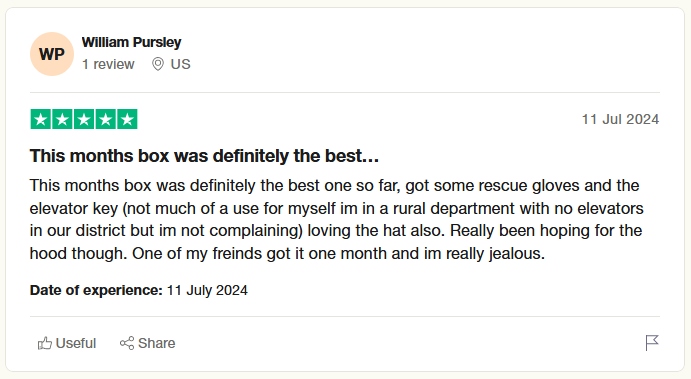
Build a community
Customers are more likely to remain loyal to your brand if it gives them a sense of identity and belonging. One of the ways to do this is to build a community around your product.
For example, Income School provides digital marketing courses, coaching and membership. But it’s also a supportive community of entrepreneurs supporting each other in building businesses.

This additional emotional connection increases their loyalty to the brand. Here are some tips for creating a community around your brand:
👨🏽🤝👨🏼 Give customers exclusive access to member-only forums and social media groups.
👨🏽🤝👨🏼 Allow customers to get involved in decision-making for your products and services.
👨🏽🤝👨🏼 Host events for your customers.
👨🏽🤝👨🏼 Invite customers to appear in podcasts, webinars and other marketing activities.
Implement an effective loyalty program
If building communities speaks to your customers’ hearts, then loyalty programs speak to their heads.
Loyalty programs are when you reward customers for buying from you or renewing their contract. Usually, it involves giving them money off future purchases or perks like express delivery.
Customers are more likely to stay with you if you reward them with value for money. In fact, customers who pay to be part of a brand’s loyalty scheme are 59% more likely to choose that company over a competitor.
Typical examples of loyalty programs include:
❤️ Points-based loyalty programs.
❤️ Tiered loyalty programs.
❤️ Paid loyalty programs.
❤️ Value-based loyalty programs.
For example, beauty subscription box providers (and Subbly customers!) Birchbox automatically transfers all subscribers to its VIP service after six months. This includes a blanket 15% discount, plus a tonne of other benefits.
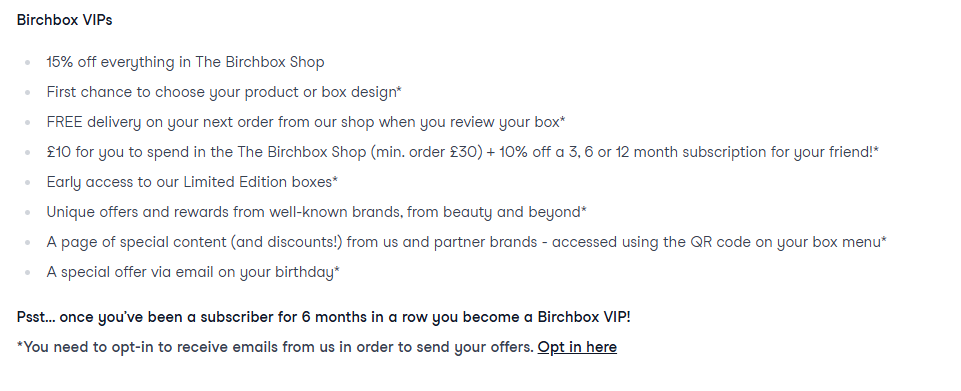
3. Create a marketing funnel
Retaining customers helps keep your business stable, but acquiring new customers is critical for growth. That’s where your marketing funnel comes in.
A marketing funnel is a way to visualize your customer’s journey across multiple channels, from first hearing about your subscription box to becoming a loyal subscriber.
It’s broken down into stages, including:
- Awareness
- Interest
- Decision
- Renewal
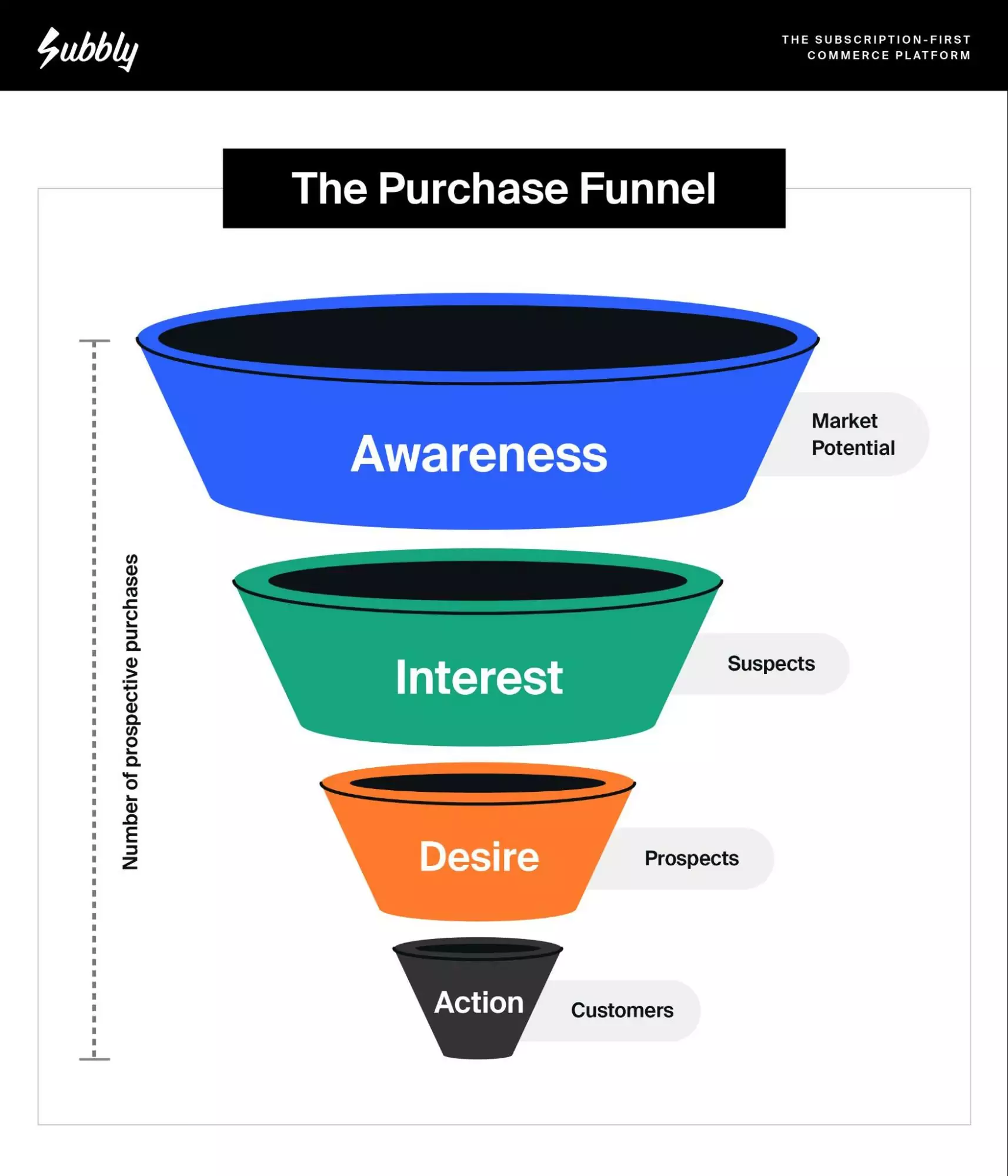
Your aim at each stage is to get the customer engaged with the next one by providing them with content that matches their relationship with your brand.
Here’s an example of how a typical marketing funnel might work:
🔍 Awareness: The customer comes across your brand by reading one of your blog posts.
🔍 Interest: The customer finds the blog post helpful and clicks a link to look at your products. They decide to sign up for your email newsletter.
🔍 Decision: The first newsletter includes an introductory offer. This encourages the customer to make a purchase.
🔍 Renewal: You provide the customer with great service and stay in touch regularly so they know how much you mean to them. Just before their subscription is up, you send them another special offer to encourage them to renew.
As mentioned earlier, certain channels and types of content suit different stages of the customer journey. Here’s a breakdown of what to consider at each stage:
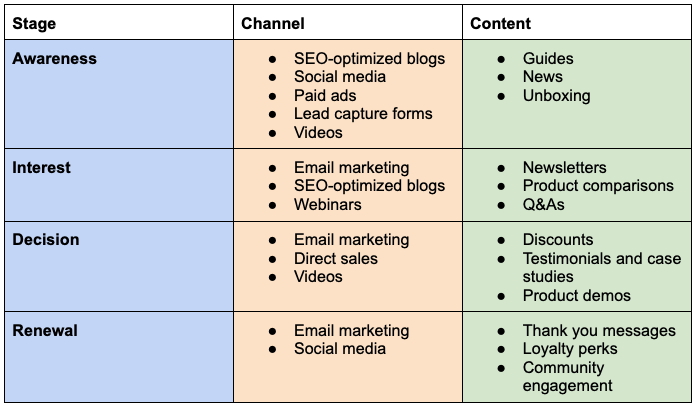
Check out the following guides for more information on scaling your subscription business using marketing:
- Subscription marketing strategy: a complete guide
- Subscription box email marketing: a complete guide
4. Connect on social media

We’ve already talked about how social media plays a role in retention and the marketing funnel. However, social media is so critical to all aspects of your subscription business that it deserves its own section.
The stats speak for themselves:
- 54% of web users use social media to research products
- 33% prefer to contact a brand via social media than phone
- 71% of users who had positive experiences with a company on social media are likely to recommend them to others
Here are some tips for ensuring you get the most out of your social media presence:
✅ Make sure your social media accounts are complete and up-to-date.
✅ Share with your audience every day.
✅ Make sure the content you share is valuable, engaging and relevant.
✅ Join groups and pages that your customers are part of and engage in conversations.
✅ Stay professional and avoid posting anything controversial.
✅ Use Pinterest to show off your products.
✅ Use Facebook and Instagram for social media advertising.
✅ Use YouTube and TikTok for unboxing videos.
✅ Respond quickly—especially to complaints and support requests.
5. Experiment with pricing strategies

Finding the right pricing mix for your subscription business is a delicate balance. The chances are that your pricing probably isn’t optimized if it’s still early days for your business—so it’s worth reviewing at least yearly.
Things to consider include:
🤔 Your costs—including materials, delivery, software, etc.
🤔 What your competitors charge
🤔 What your target market is willing to spend
🤔 How much profit you want to make
Pricing is difficult because, while some customers may be attracted to low prices, others may be put off, assuming that it reflects poor product quality.
You may wish to provide a range of different pricing options for customers, as this will enable you to attract the widest range of customers, while also capitalizing on those willing to spend more.
This is called tiered pricing. Below is a good example of this in action. Bitsbox provides educational activities for children. It offers three different price points, helping lower-budget customers to afford a subscription.
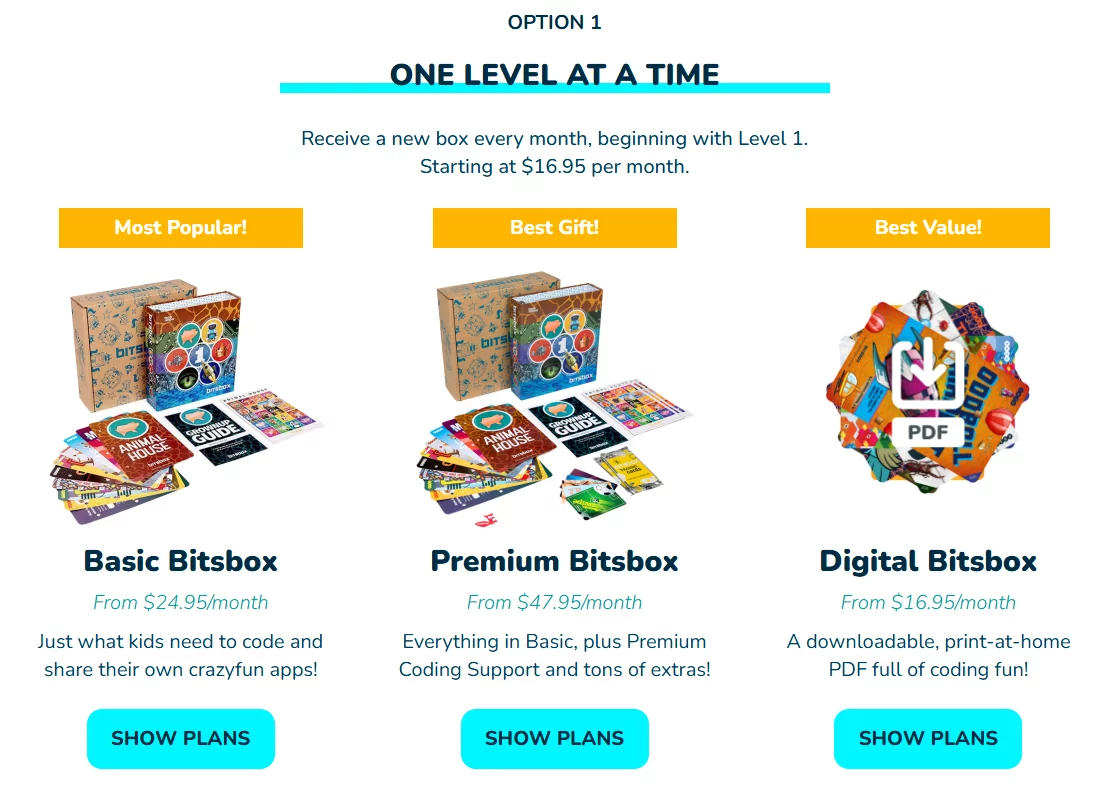
Some other common subscription pricing strategies include:
💲Flat-rate: This is when you charge a single price. This suits companies whose products or services have limited features and a defined buyer persona.
💲Cost plus: You calculate the total cost of providing your product or service and then add a markup for profit. This suits businesses with predictable revenue and stable costs.
💲Competitor-based: You set your subscription plans in line with the pricing structures of your competitors. This pricing strategy best suits companies in competitive niches.
💲Value-based: This is based on your product’s perceived value to your customers. This model suits businesses that sell luxury goods.
💲Freemium pricing model: You provide a free basic version of your product or service. Customers need to subscribe to access full use. This usually suits software businesses.
💲Usage-based model: Your subscription’s price is based on how much of your product a customer orders or uses. This suits businesses where measuring how much of a product customers use is easy.
Learn more: Read our guide to smart and effective pricing strategies.
6. Improve upselling and cross-selling

Upselling and cross-selling are ingenious ways to deliver more value to customers.
💡 Upselling is when you encourage a customer to sweeten their deal by purchasing a higher-value subscription or adding a one-time product.
💡 Cross-selling is encouraging customers to add something else to their order that’s not directly related to what they’re currently buying. A clear example is Amazon recommending additional books when you add one to your cart, saying, “readers also bought these.”
Both of these tactics work well because they target customers when they’re most ready to buy—for example, during the checkout process.
There are three places you can upsell or cross-sell in your sales funnel:
- Offer a promotion before the buying process to encourage them to check out sooner.
- Promote something additional to add to their order during check out.
- Follow up with offers or recommend new products after they have made a purchase.
Experiment with different offerings to find what drives the most impact for your business.
Be thoughtful in how you go about it—avoid harassing customers with promotions, as this risks tarnishing your brand.
Evan McCarthy from sports dental protection provider Sporting Smiles shares how he keeps in touch with customers without bombarding them:
“What has worked well for us is to offer the customer an option of how many emails they would like to receive from us.
“This increases positive responses to our emails and eliminates customers cancelling subscriptions.
“We generally send out emails bi-monthly with a good chunk of information rather than annoying low info daily emails.”
7. Set up a referral program

Referral programs involve you offering discounts or incentives to customers who get another customer to buy a subscription.
They’re effective because people trust recommendations from friends or family. In fact, 90% of people will make a purchase based on someone else’s advice.
Antreas Koutis, of financial services comparison website Financer, explains how he grew his subscription business with an effective referral program:
“We scaled our business by using a referral system that gave our customers an incentive to share our service with their friends and family.
“For every new customer that signed up using their referral code, we gave them a month of service for free. This not only helped us to attract new subscribers, but it also helped to keep our existing customers engaged.
“As a result, we grew our business sustainably and developed a loyal customer base.”
The great thing about a referral system is that it runs on autopilot once you set it up. When building your referral system, consider what incentives will drive the most action.
They could include:
👉 Freebies: Whether it’s a free month or merchandise, freebies are a great way to incentivize action.
👉 Hard cash: Many companies offer cash incentives to entice people to fill out surveys or refer others.
👉 Social shoutout: Some companies incentivize social media shares by resharing them from a company profile. If you have a large following, this can be a great way to encourage engagement on your social profiles and promote user-generated content.
Referral systems are a great way to reward word of mouth. And word of mouth is the most powerful marketing strategy. If you stall on building a referral program, you may leave a lot on the table.
Whether you leverage a referral strategy or the other strategies we’ve covered so far, you need to know what works. You’ll need systems to monitor your key performance metrics to do that.
8.Monitor key performance metrics

Focusing on sales won’t necessarily show whether your business is scaling successfully. For example, what if staffing and material costs exceed your subscription revenue?
You need to monitor a range of business metrics to ensure your business is performing well across the board.
There are 11 key performance indicators that subscription businesses should track.
Let’s briefly look at each of them.
📊 Monthly recurring revenue (MRR): The average monthly subscription revenue you earn for each subscriber, multiplied by the total number of subscribers. Tracking helps with your cash flow management.
📊 Annual recurring revenue (ARR): Multiply your MRR across 12 months. Doing so helps with annual reporting. Note that ARR and MRR don’t include promotions or free trials as they would inflate the results. These two metrics only forecast recurring revenue, not one-time purchases.
📊 Average revenue per user (ARPU): Your MRR divided by the total number of customers you have. This metric is useful if you have different tiers of customers like starter or premium subscribers to a subscription newsletter.
📊 Customer acquisition cost (CAC): The amount you spend to bring in the customers you have.
📊 Churn rate: The number of customers that unsubscribe divided by the number of subscribers you had.
📊 Customer lifetime value (CLV) or lifetime value (LTV): The average amount a customer spends throughout their relationship with your business.
📊 Payback period (PBP): The amount of time it takes you to pay off your CAC. It’s your breakeven point.
📊 Gross margin: This is the difference between your sales and operating costs expressed as a percentage.
📊 Average order value (AOV): This tells you how much money a customer spends on average on a single order.
📊 General website metrics: This range of measurements gives you insights into customer behavior on your website. It includes search impressions, click-through rates and time on page.
A good example of a company that failed to monitor the right metrics is the meal kit prep subscription service, Blue Apron.
The company was spending a lot to acquire customers, and those customers were churning before Blue Apron could make that money back. This was unsustainable and the company saw its stock value plunge.
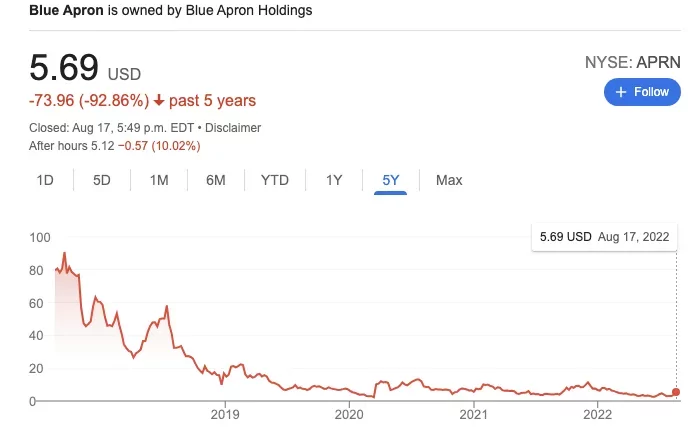
9. Watch your competition

Keeping an eye on your competitors is critical to continued growth. It helps you identify threats and potential opportunities as they arise.
For example, what if a rival subscription box suddenly slashes their prices? Will they steal your customers? How can they afford to do this? Is it sustainable? How can you retain customers?
Thomas Griffin from OptinMonster shares in a Forbes expert roundup on competitor analysis that you should “make a list of 5-10 of your biggest competitors and only monitor those ones.”
Here’s what you should look at when doing a competitor analysis:
🔍 Look at their website
🔍 Look at their reviews
🔍 Look at their social media profiles
If they’re growing, try to understand what makes them successful. Maybe you can reverse engineer what works for them or find a gap in their strategy.
You may scoff, saying, “I’m no copycat,” but many businesses find success doing what others have already done, but better.
Scale Your Subscriptions Business With Subbly
Scaling your subscription box business is no small feat, but with the right strategies in place, it’s absolutely achievable.
From improving customer retention and creating a marketing funnel to leveraging upselling and monitoring key metrics, each approach discussed in this article is designed to fuel sustainable growth.
The right tools make all the difference. Subbly is built specifically for subscription businesses, offering features like automated billing, customizable checkout experiences, and powerful retention tools—all in one platform.
By switching to Subbly, you can eliminate inefficiencies, improve customer experience, and focus on scaling your business with confidence.
Ready to grow? Get started with Subbly today.


